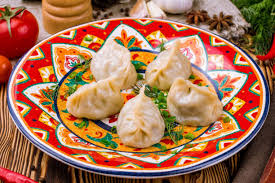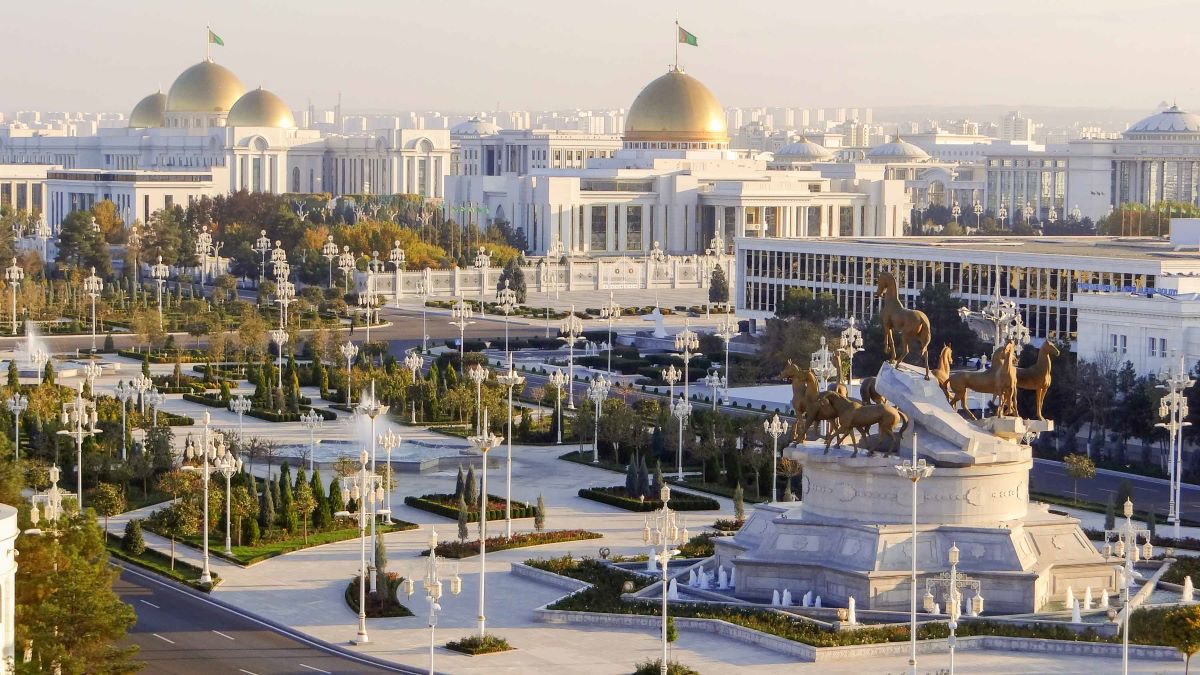Turkmenistan, a country located in Central Asia, is known for its vast deserts, rich history, and unique cultural heritage. Bordered by the Caspian Sea to the west, Kazakhstan to the northwest, Uzbekistan to the northeast, Afghanistan to the southeast, and Iran to the south, Turkmenistan is a nation of contrasts, combining natural beauty with a deep-rooted historical significance. This blog delves into the geography, history, culture, economy, and tourism potential of Turkmenistan.
Table of Contents
Geography of Turkmenistan
Turkmenistan occupies an area of approximately 491,210 square kilometers, making it the second-largest country in Central Asia. The landscape is predominantly characterized by the Karakum Desert, which covers about 70% of the nation. This desert region is not only vast but also home to unique flora and fauna adapted to harsh conditions.
The eastern part of Turkmenistan features the Kopet Dag mountain range, which rises dramatically from the plains. This range not only serves as a natural barrier between Turkmenistan and Iran but also offers a stark contrast to the surrounding desert. The country also has several important rivers, including the Amu Darya, which flows along its border with Uzbekistan.
Turkmenistan experiences a continental climate, with hot summers and mild winters. The arid conditions limit agricultural activities, but the country has made significant strides in irrigation and land management to enhance agricultural productivity. The nation’s natural resources, particularly natural gas and oil reserves, play a crucial role in its economy.
States of Turkmenistan
Turkmenistan is divided into five administrative regions known as “vilayats,” along with the capital city, Ashgabat. The five vilayats are:
| No. | Vilayat | Capital |
|---|---|---|
| 1 | Ahal | Ashgabat |
| 2 | Balkan | Turkmenbashy |
| 3 | Dashoguz | Dashoguz |
| 4 | Lebap | Turkmenabat |
| 5 | Mary | Mary |
A Glimpse into History
The history of Turkmenistan is rich and complex, shaped by various civilizations and empires that have risen and fallen in the region. The territory has been inhabited since ancient times, with archaeological evidence pointing to the presence of nomadic tribes as far back as the Neolithic period.
One of the earliest known civilizations in Turkmenistan was the Margiana, which flourished around 2000 BCE. This Bronze Age culture is known for its impressive urban settlements and advanced metallurgy. The region later became part of the Achaemenid Empire and saw the influence of Alexander the Great, who traversed Central Asia in the 4th century BCE.
The Silk Road, the ancient trade route connecting East and West, passed through Turkmenistan, facilitating the exchange of goods, culture, and ideas. Cities like Merv, once a thriving oasis and a major trading center, became melting pots of diverse cultures and religions.
In the medieval period, Turkmenistan was part of the Seljuk Empire, followed by the Mongol invasions led by Genghis Khan in the 13th century. The territory eventually fell under the rule of various khanates and empires, including the Persian Empire and the Russian Empire in the 19th century.
Turkmenistan gained independence from the Soviet Union in 1991, and since then, it has sought to establish its identity as a sovereign nation while navigating the complexities of international relations.
Top Ten Must-Visit Destinations in Turkmenistan
Turkmenistan is a country rich in natural beauty and historical significance, offering a variety of unique destinations beyond its cities. Here’s a look at the top ten must-visit destinations that showcase the stunning landscapes, ancient ruins, and cultural heritage of this Central Asian gem.
- Darvaza Gas Crater (Door to Hell)

Located in the Turkmen Karakum Desert, the Darvaza Gas Crater, popularly known as the “Door to Hell,” is one of Turkmenistan’s most famous natural wonders. This massive crater, created in the 1970s when a Soviet drilling rig collapsed, has been burning continuously ever since. The fiery glow of the crater against the dark desert landscape creates a mesmerizing sight, especially at night. Visitors can explore the area around the crater, taking in the surreal atmosphere and capturing stunning photographs of this unique phenomenon.
- Merv

Merv is an ancient city that was once a major stop along the Silk Road, showcasing the wealth and culture of the region. Today, it is a UNESCO World Heritage Site and one of the largest archaeological sites in Central Asia. The ruins of Merv include well-preserved structures such as the Great Kyz Kala fortress, the Mausoleum of Sultan Sanjar, and the ancient city walls. Exploring Merv offers visitors a glimpse into the grandeur of the past and the opportunity to walk through history.
- Kunya-Urgench

Kunya-Urgench, another UNESCO World Heritage Site, is home to remarkable architectural monuments dating back to the 11th and 12th centuries. The site features the stunning Kutlug-Timur Minaret, one of the tallest minarets in Central Asia, and the intricately decorated mausoleums of Turabeg Khanym and Sultan Tekesh. The rich history and beautiful architecture make Kunya-Urgench a must-visit destination for those interested in the region’s Islamic heritage.
- Yangykala Canyon

Yangykala Canyon, located in western Turkmenistan, is a breathtaking natural wonder characterized by its colorful rock formations and dramatic cliffs. The canyon’s vibrant hues, ranging from deep reds to bright yellows, create a stunning contrast against the blue sky. Hikers and nature lovers can explore the canyon’s trails and take in the breathtaking views of this unique landscape. It’s an excellent destination for photography enthusiasts and adventure seekers alike.
- Nisa Fortress

The ancient Nisa Fortress, located just outside of Ashgabat, is an important archaeological site and a UNESCO World Heritage Site. Once the capital of the Parthian Empire, Nisa features the ruins of a complex that includes temples, palaces, and a large number of burial mounds. Visitors can explore the remnants of this ancient city, learn about its historical significance, and enjoy panoramic views of the surrounding landscape.
- Kopet Dag Mountains

The Kopet Dag Mountains, which form a natural border between Turkmenistan and Iran, offer stunning scenery and opportunities for outdoor activities. The mountains are home to diverse flora and fauna, as well as beautiful hiking trails that lead to picturesque vistas. Nature enthusiasts can enjoy trekking, camping, and birdwatching in this scenic region, experiencing the tranquility and beauty of Turkmenistan’s natural landscapes.
- Ahal Tepe

Ahal Tepe is an archaeological site located near Ashgabat, known for its ancient ruins that date back to the Bronze Age. The site features well-preserved artifacts, including pottery, tools, and jewelry, providing insight into the lives of the early inhabitants of the region. Exploring Ahal Tepe allows visitors to appreciate the rich cultural history of Turkmenistan and the significance of this site in understanding the region’s past.
- Turkmenbashy Ruhy Mosque

Situated in the city of Turkmenbashy, the Turkmenbashy Ruhy Mosque is a magnificent architectural marvel and one of the largest mosques in Central Asia. The mosque features stunning blue and white tile work, a grand dome, and intricate carvings, making it a captivating destination for those interested in Islamic architecture. Visitors can explore the mosque’s grounds, learn about its significance, and experience the serene atmosphere it offers.
- Lake Avaz

Lake Avaz, located on the Caspian Sea coast, is a popular destination for relaxation and recreation. The area around the lake features beautiful beaches, resorts, and recreational facilities, making it an ideal spot for swimming, sunbathing, and enjoying water sports. The picturesque views of the lake and the surrounding landscape provide a peaceful escape from the hustle and bustle of urban life.
- Teppe Village

Teppe Village is a traditional Turkmen village that offers visitors a glimpse into the rural lifestyle of the Turkmen people. The village is known for its traditional adobe houses, vibrant local culture, and friendly residents. Visitors can immerse themselves in the local way of life, enjoy traditional meals, and participate in cultural activities such as carpet weaving and horseback riding. Exploring Teppe Village provides a unique opportunity to connect with the rich traditions and hospitality of the Turkmen people.
Culture and Traditions
Turkmenistan boasts a vibrant culture deeply rooted in its nomadic heritage. The people of Turkmenistan, known as Turkmen, are known for their hospitality and strong sense of community. Traditional customs and rituals play a significant role in daily life, with family gatherings and celebrations being integral to their social fabric.
One of the most notable aspects of Turkmen culture is its rich tradition of carpet weaving. Turkmen carpets, renowned for their intricate designs and vibrant colors, are considered a symbol of national identity. Each carpet tells a story, often reflecting the history and culture of the region. The art of carpet weaving is passed down through generations, preserving the skills and techniques that have been honed over centuries.
Music and dance are also vital components of Turkmen culture. Traditional instruments such as the dutar and the gopuz accompany folk songs and dances that celebrate everyday life, love, and nature. Festivals and ceremonies often feature lively performances, showcasing the cultural heritage of the Turkmen people.
The Turkmen language, a member of the Turkic language family, is the official language of the country. It has several dialects and is an essential aspect of Turkmen identity. The country’s commitment to preserving its language and culture is evident in educational policies and cultural initiatives.
Top Eight Most Famous Food of Turkmenistan








Economy and Natural Resources
Turkmenistan’s economy is heavily reliant on its vast natural resources, particularly natural gas, oil, and mineral deposits. The country holds some of the largest natural gas reserves in the world, making it a key player in the global energy market. The government has invested significantly in developing the energy sector, including the construction of pipelines to export natural gas to neighboring countries and beyond.
Agriculture also plays a vital role in the economy, with cotton being one of the primary cash crops. The government promotes cotton production through state-sponsored initiatives, although this has faced criticism for its environmental impact and labor practices.
In recent years, Turkmenistan has sought to diversify its economy by investing in industries such as textiles, construction, and tourism. The government has implemented policies to attract foreign investment and develop infrastructure, aiming to enhance economic growth and create job opportunities.
Tourism Potential
Despite its rich history and natural beauty, Turkmenistan remains relatively undiscovered as a tourist destination. The government has recognized the potential for tourism to contribute to the economy and has taken steps to promote the country as a travel destination.
One of the most iconic attractions in Turkmenistan is the Door to Hell, a natural gas crater that has been burning since it was ignited by Soviet geologists in the 1970s. This surreal site draws visitors from around the world who are fascinated by its fiery glow against the stark desert backdrop.
The ancient city of Merv, a UNESCO World Heritage Site, is another must-visit destination. Once a major trading hub along the Silk Road, Merv boasts well-preserved ruins, including mosques, mausoleums, and fortifications that provide a glimpse into its storied past.
Ashgabat, the capital city, is known for its striking architecture and grand monuments. The city features white marble buildings, lush parks, and impressive statues, reflecting the ambitions of the Turkmen government to create a modern metropolis. The Neutrality Monument and the Arch of Neutrality are among the city’s most recognizable landmarks.
The country’s natural landscapes, including the stunning Kopet Dag mountains and the tranquil shores of the Caspian Sea, offer opportunities for outdoor activities such as hiking, camping, and beach relaxation. The unique flora and fauna of the Karakum Desert provide a backdrop for adventure tourism, appealing to nature enthusiasts and adventure seekers.
Conclusion
Turkmenistan, the land of endless deserts and rich heritage, is a country that captivates with its natural beauty and cultural depth. From the vast expanse of the Karakum Desert to the historical treasures of ancient cities, Turkmenistan offers a unique blend of history, culture, and adventure. As the country continues to develop its economy and tourism potential, it stands at a crossroads, embracing its past while looking toward a promising future. For those willing to explore its hidden gems, Turkmenistan promises an unforgettable journey into the heart of Central Asia.
let’s enjoy few years on earth with peace and happiness….✍🏼🙏

